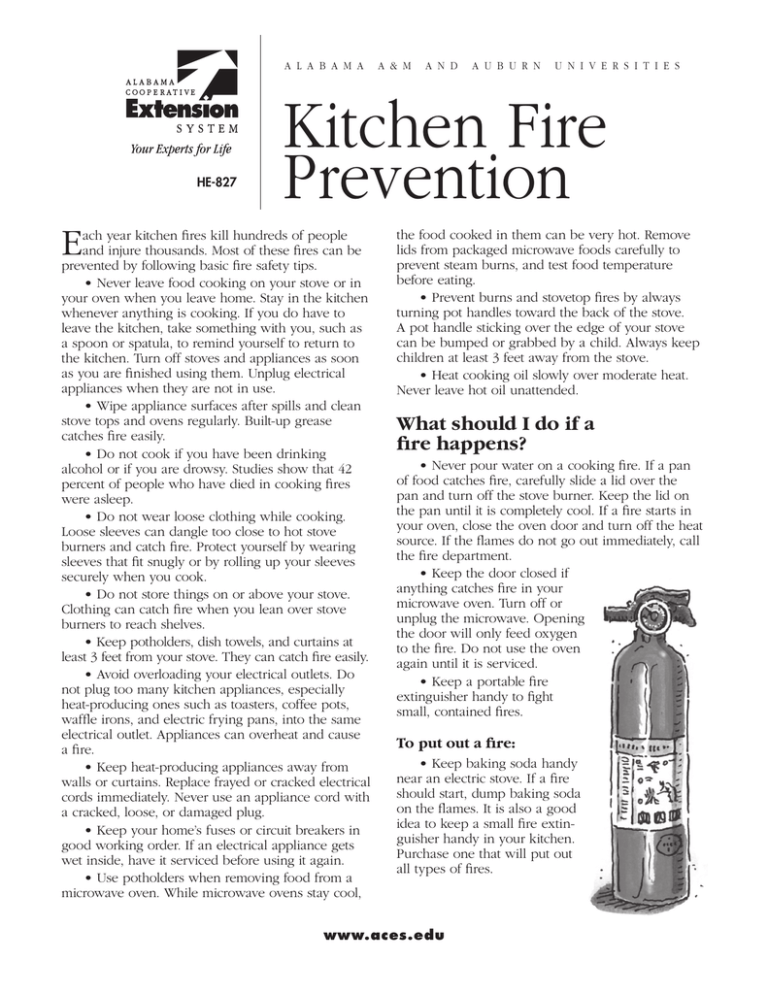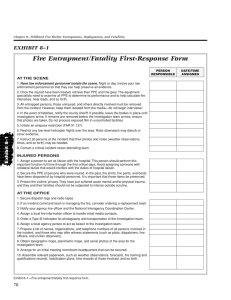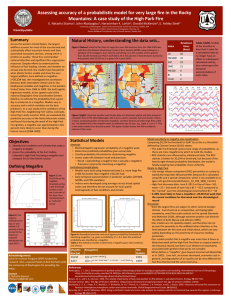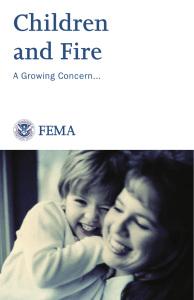
A L A B A M A
HE-827
E
A & M
A N D
A U B U R N
U N I V E R S I T I E S
Kitchen Fire
Prevention
ach year kitchen fires kill hundreds of people
and injure thousands. Most of these fires can be
prevented by following basic fire safety tips.
• Never leave food cooking on your stove or in
your oven when you leave home. Stay in the kitchen
whenever anything is cooking. If you do have to
leave the kitchen, take something with you, such as
a spoon or spatula, to remind yourself to return to
the kitchen. Turn off stoves and appliances as soon
as you are finished using them. Unplug electrical
appliances when they are not in use.
• Wipe appliance surfaces after spills and clean
stove tops and ovens regularly. Built-up grease
catches fire easily.
• Do not cook if you have been drinking
alcohol or if you are drowsy. Studies show that 42
percent of people who have died in cooking fires
were asleep.
• Do not wear loose clothing while cooking.
Loose sleeves can dangle too close to hot stove
burners and catch fire. Protect yourself by wearing
sleeves that fit snugly or by rolling up your sleeves
securely when you cook.
• Do not store things on or above your stove.
Clothing can catch fire when you lean over stove
burners to reach shelves.
• Keep potholders, dish towels, and curtains at
least 3 feet from your stove. They can catch fire easily.
• Avoid overloading your electrical outlets. Do
not plug too many kitchen appliances, especially
heat-producing ones such as toasters, coffee pots,
waffle irons, and electric frying pans, into the same
electrical outlet. Appliances can overheat and cause
a fire.
• Keep heat-producing appliances away from
walls or curtains. Replace frayed or cracked electrical
cords immediately. Never use an appliance cord with
a cracked, loose, or damaged plug.
• Keep your home’s fuses or circuit breakers in
good working order. If an electrical appliance gets
wet inside, have it serviced before using it again.
• Use potholders when removing food from a
microwave oven. While microwave ovens stay cool,
the food cooked in them can be very hot. Remove
lids from packaged microwave foods carefully to
prevent steam burns, and test food temperature
before eating.
• Prevent burns and stovetop fires by always
turning pot handles toward the back of the stove.
A pot handle sticking over the edge of your stove
can be bumped or grabbed by a child. Always keep
children at least 3 feet away from the stove.
• Heat cooking oil slowly over moderate heat.
Never leave hot oil unattended.
What should I do if a
fire happens?
• Never pour water on a cooking fire. If a pan
of food catches fire, carefully slide a lid over the
pan and turn off the stove burner. Keep the lid on
the pan until it is completely cool. If a fire starts in
your oven, close the oven door and turn off the heat
source. If the flames do not go out immediately, call
the fire department.
• Keep the door closed if
anything catches fire in your
microwave oven. Turn off or
unplug the microwave. Opening
the door will only feed oxygen
to the fire. Do not use the oven
again until it is serviced.
• Keep a portable fire
extinguisher handy to fight
small, contained fires.
To put out a fire:
• Keep baking soda handy
near an electric stove. If a fire
should start, dump baking soda
on the flames. It is also a good
idea to keep a small fire extinguisher handy in your kitchen.
Purchase one that will put out
all types of fires.
www.aces.edu
To use a fire extinguisher:
When fighting small fires, remember PASS – pull,
aim, squeeze, sweep.
• Pull the pin. This unlocks the operating lever
and allows you to discharge the extinguisher.
• Aim low. Point the extinguisher nozzle or hose
at the base of the fire and not at the flames.
• Squeeze the lever above the handle. This
discharges the extinguishing agent. Release the lever
to stop the discharge.
• Sweep from side to side, moving carefully
toward the fire. Keep the extinguisher aimed at the
base of the fire and sweep back and forth until the
flames are out. Watch the fire area. If the fire starts
again, repeat the process.
Stephanie Woodyard, Extension Specialist, Family Programs
For more information, call your county Extension office. Look in your telephone directory under your county’s name to find the number.
HE-827
Issued in furtherance of Cooperative Extension work in agriculture and home economics, Acts
of May 8 and June 30, 1914, and other related acts, in cooperation with the U.S. Department of
Agriculture. The Alabama Cooperative Extension System (Alabama A&M University and Auburn
University) offers educational programs, materials, and equal opportunity employment to all people
without regard to race, color, national origin, religion, sex, age, veteran status, or disability.
4M, New Jan 2006, HE-827
© 2006 by the Alabama Cooperative Extension System. All rights reserved.






